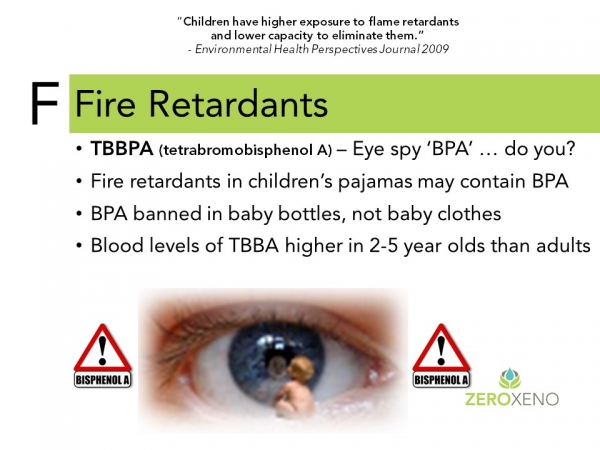Our products are proudly manufactured in Canada and are a product of Canada.
The 7 Deadly Estro-Sins: Fire Retardants
November 06, 2019

"Eye spy with my little eye the xenoestrogen that begins with the letter 'T' that is not BPA-Free!"
Yes it's true, a cousin of bisphenol A (BPA), the estrogen mimicking xenoestrogen the Canadian Government banned in baby bottles, is allowed in your baby's pajamas. Unfortunately many clothing manufacturers use fire retardants in sleepwear your children go to bed in every night. This chemical is called tetrabromobisphenol A or TBBPA for short and is the halogenated version of BPA that's linked to ovarian cancer, uterine cancer and other hormone issues.
Various studies reveal that disturbed thyroid signaling is related to TBBPA. Scientists point out that this xenoestrogen has thyroid-disrupting effects similar to PCBs. Additionally, TBBPA is proven to be absorbed through the skin, which means that if TBBPA is hidden in your children's pajamas, it's lurking in their bodies too. A 2010 study reported levels of TBBPA in 2-5 year old children in California to be 2-50X higher than adults.
Many of you will recognize the last part of the word tetrabromobisphenol A, also known as BPA. Now, before you throw your hands up in disgust and say "There's no ingredient label on my child's pajamas so how can I find out if this chemical is in them or not!" let me give you a few simple tips. They're easy to remember, and will help you recognize if your children's pj's are tainted with this nasty hormone disruptor.
Check the Fabric
Flame retardants are synthetic chemicals that don't adhere to cotton or natural fibers very well. Synthetic chemicals love synthetic fabric, or as the old adage goes, "Birds of a feather flock together." So, if your children's pajamas are 100% polyester (a synthetic fiber) you might want to toss them as they're likely polluted with TBBPA.
The Canadian Government does require some fire retardants to be listed on clothing labels, but sadly manufacturers have found a way around this regulation. Many synthetic fibers are infused with TBBPA before they are made into clothing, and therefore company's aren't required to list the fire retardant on the final garment because they didn't add the chemical during the process of manufacturing.
So the choice is simple then, choose cotton and/or other natural fabric pajamas because TBBPA and other estrogenic fire retardants aren't likely be in hidden in them.
It's interesting to note that a study discovered TBBPA, found in laundry wastewater in the Columbia River, was shown to originate from laundered clothing. Just think, by purchasing natural pj's you will not only be keeping your little one safe but helping the environment too!
Sniff Out Chemicals
My second tip of the day is to start utilizing the 'sniff test.' Every time you purchase new pj's for your little ones, smell them before purchasing. If they smell chemically pungent, it's probably because they contain TBBPA. Of course I would recommend you go one step further and take the offending item to the clothing manager and educate them. Politely inform the supervisor that you vote with your wallet and you cast your ballot for your child's clothes to be xenoestrogen-free. We all can make a difference one purchase at a time!
Environmental Solutions
Scientists have recently discovered how to turn TBBPA into harmless carbon dioxide and water. It's good to know the scientific community is making efforts to develop safe and effective processes to protect our drinking and groundwater from TBBPA contamination by apply their technology to waste water treatment plants.
Avoiding toxic hormone disruptors is made simple and easy if you learn all of the 'BSFACTS'!
Join The Zero Xeno Movement today!
By Bonnie Penner
All Zero Xeno (ZX Enterprises Inc.) products are for external use only. All advice and information posted on this website is from personal research and/or experience and is intended for general educational purposes. Our intent is not to diagnose, treat, cure or prevent any disease. The information on our site is not intended to be a substitute for professional medical advice related to specific medical conditions. We cannot diagnose illnesses nor confirm any claim as to therapeutic safety, effectiveness or course of treatment. Always seek the advice of your physician or other qualified health professionals for any concerns regarding your health. Only your physician can provide specific diagnosis and treatments. Please refer to our full Disclaimer for more details.
- Log in to post comments



